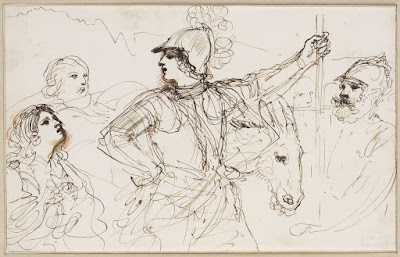 |
| Guercino (Giovanni Francesco Barbieri) St Gregory the Great with Sts Ignatius Loyola and Francis Xavier ca. 1625-26 oil on canvas National Gallery, London |
 |
| Guercino (Giovanni Francesco Barbieri) St Gregory the Great with Sts Ignatius Loyola and Francis Xavier ca. 1625-26 drawing (compositional study) Ashmolean Museum, Oxford |
 |
| Guercino (Giovanni Francesco Barbieri) St Gregory the Great with Sts Ignatius Loyola and Francis Xavier ca. 1625-26 drawing (figure study - St Gregory) British Museum |
 |
| Guercino (Giovanni Francesco Barbieri) St Gregory the Great with Sts Ignatius Loyola and Francis Xavier ca. 1625-26 drawing (figure studies - Putti) Royal Library, Windsor |
"This altarpiece [of St Gregory the Great] was painted for the Ludovisi family in Rome, probably for Cardinal Ludovico Ludovisi, who, following the death of his uncle Pope Gregory XV, had decided to erect a church in Rome dedicated to the Catholic missionary St Ignatius Loyola. With St Francis Xavier, fellow missionary and co-founder of the Jesuits, Ignatius had been canonized on 12 Mach 1622, towards the end of Pope Gregory's reign. The Ludovisi were devoted followers of the Jesuits, and the plan was to erect Pope Gregory's tomb, as well as those of the Cardinal and other family members, in the new church. . . . Even though Guercino had left Rome in 1623 at the Pope's death, he understood the Ludovisi family's extravagant taste and obliged them accordingly. . . . This is among the most lavishly painted of all Guercino's works. Much of its surface of deep impasto is given over to St Gregory's ponderous cope, embroidered in gold, set off by panels of red and some blue. The sky of the deepest, purest (and most expensive) ultramarine compliments these colours, magnifying the picture's already vibrant effect. The painter used this colour contrast for many more years, with the same success."
 |
| Guercino (Giovanni Francesco Barbieri) David and Abigail ca. 1625-27 oil on canvas (cut down on all sides by an unknown former owner) private collection |
 |
| Guercino (Giovanni Francesco Barbieri) David and Abigail ca. 1625-27 drawing (compositional study) Teylers Museum, Haarlem |
 |
| Guercino (Giovanni Francesco Barbieri) David sending the Letter to Joab ca. 1625-27 oil on canvas (cut down on all sides by an unknown former owner) private collection |
 |
| Giovanni Battista Pasqualini after Guercino David sending the Letter to Joab 1627 engraving British Museum |
 |
| Guercino (Giovanni Francesco Barbieri) Jupiter and Semele 1626 oil on canvas (cut down on all sides by an unknown former owner) private collection |
 |
| Guercino (Giovanni Francesco Barbieri) Jupiter and Semele 1626 drawing (compositional study) Royal Library, Windsor |
 |
| Giovanni Battista Pasqualini after Guercino Jupiter and Semele 1626 engraving Philadelphia Museum of Art |
 |
| Guercino (Giovanni Francesco Barbieri) Peace ca. 1626-27 detached fresco Galleria Estense, Modena |
 |
| Francesco Rosaspina after Guercino Peace 1800 etching British Museum |
"[Carlo Cesare] Malvasia did not mention the fresco, but a century later [Orazio Cammillo] Righetti recorded it as by Guercino and located in the Casa Tassinari, Cento, the same location as cited in Rosaspina's reproductive print of 1800. Though the fresco was probably made to decorate the chimneybreast of a large reception room in a Centese residence, it is unclear if the Casa Tassinari was the original location. The detached fresco later belonged to the Taddia family of Bologna."
 |
| Guercino and workshop Supper at Emmaus ca. 1626 oil on canvas Pinacoteca Civica, Cento |
 |
| Guercino (Giovanni Francesco Barbieri) Supper at Emmaus ca. 1626 drawing (compositional study) Staatsgalerie, Stuttgart |
 |
| Antonio Lorenzini after Guercino and workshop Supper at Emmaus ca. 1700 etching British Museum |
The reason for the omission of The Supper at Emmaus (c. 1626) from the 2017 Catalogue Raisonné is unknown, since that source does not include a section covering works rejected by the compiler. However, the Pinacoteca Civica in the artist's hometown of Cento displays the painting as a collaboration between Guercino and his workshop assistants.
– quoted texts from The Paintings of Guercino: a revised and expanded catalogue raisonné by Nicholas Turner (Rome: Ugo Bozzi Editore, 2017)